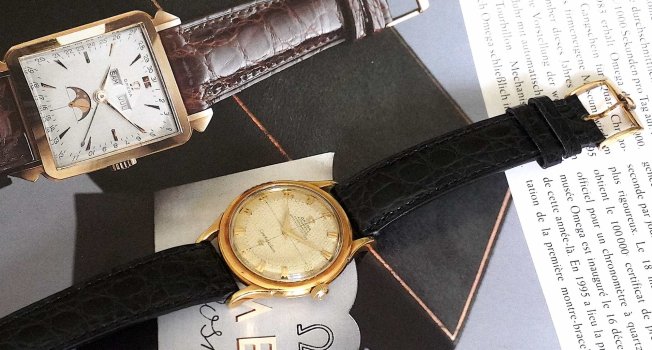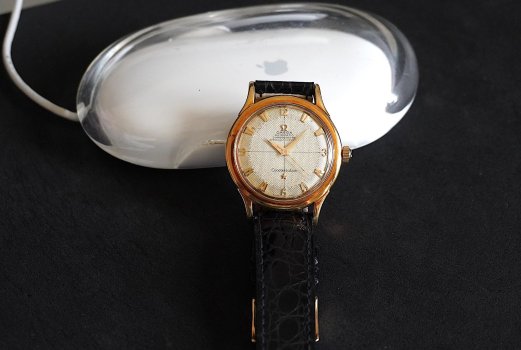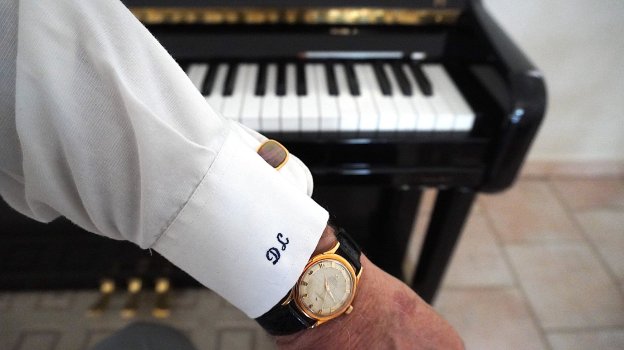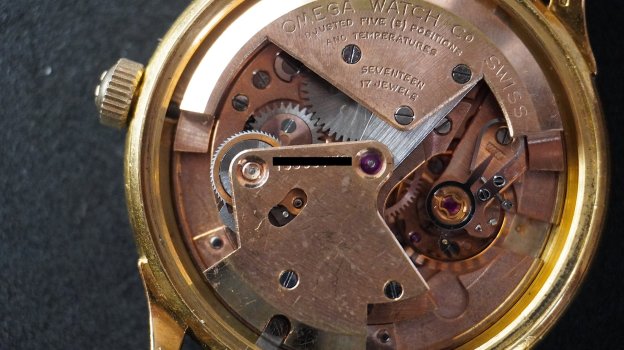The post #4,996 above of the Omega motivated me to show this one.
An Omega iconic 'Pie-Pan' Constellation officially certified chronometer, model 2652 5C bumper automatic, with solid 18kt case - the lower of the two shown below.
(It pales in comparison to the upper catalogue photo of a rare and delighfully collectable 1950's gold 'Cosmic' model full calendar moonphase).
View attachment 2236723
This Omega Constellation was the 2nd vintage watch I purchased 20+ years ago (after the IWC described in post #4,836).
I knew very little about watch collecting at that time, and didn't even ask to view the movement beforehand.

It seems I was lucky - as it's a gem!
View attachment 2236936
The ivory colour honeycomb dial is of the so-called 'Pie-Pan' design. This one has the indices as well as the Omega logo applied in gold, complete with gold dauphine hands. The case is 18kt yellow gold. Some slight discoloration on the dial, which imho compliments the antique look and may attest to the watch as being unrestored - which is always a plus.
The watch is circa 1952, one of the very first legendary 'Constellation' models, so called from the embossed emblem on the caseback which depicts an observatory with 8 stars above it, symbolising Omega's exceptional chronometer timekeeping achievements.
View attachment 2237057
View attachment 2236945
View attachment 2237031
The Constellation was the flagship wristwatch from Omega in the early 50's, just a few years earlier than the first iconic Speedmaster chronograph in '57.
Like the Speedmaster this is an automatic self-winding movement, but with a significant difference. Modern automatics have a rotor which spin a full 360degrees to wind the mainspring, whilst the bumper rotor moves through 120degrees to bump against a pair of buffer springs on opposite sides. This regular
bumping can be felt on the wrist whilst wearing, which gives the not unpleasant feeling that one is truly 'communicating' with the timepiece. You're always reminded that you're wearing a part of horological history!
Bumper movements were in the first automatic wristwatches created by John Harwood and date from the 1920's. It's therefore a myth that Rolex were the inventor of the automatic wristwatch as many tend to believe.
Some of the early Omega Seamasters also had a bumper auto movement, a Cal.351 I believe.
Although somewhat familiar with these movements from my horological library, I had never actually set eyes on mine, so whilst penning this I decided to open her up and take a few photos.
This actual movement is the Cal.354 which has a power reserve of approx 35hrs. Not having been serviced for over 25 years and thus lacking efficient lubrication, it's very rarely worn as this would accelerate internal wear. For these brief photos however it still runs extremely well, although no longer within COSC limits.
View attachment 2236971 View attachment 2236977
A final on-the-wrist photo.
View attachment 2236983







